|
With satellite imagery increasingly being used for archaeological investigations The Morien Institute has decided to report
discoveries in our Astro-Archaeology news archive
Likewise, many ancient legends that have previously been dismissed as purely “mythological” are now proving to be based on fact, and so
The Morien Institute has decided to also report these new
discoveries in our Astro-Archaeology news archive
Alongside these will be material about ancient astrological beliefs which were inextricably inter-linked with archaic astronomical science
“Aborigines may have been first astronomers”
December 31, 2009, New Zealand Herald, New Zealand
“Aboriginal Australians may have been the world’s earliest astronomers, says a Sydney scientist who has used ancient ‘Dreaming’ stories and Google Earth maps to locate a previously unknown meteorite crater in the Northern Territory.
A Sydney scientist says Aboriginal Australians knew more about the
night skies than they have been given credit for
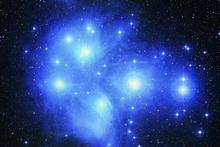
, New Zealand Herald
While researching the role of the night sky in traditional Aboriginal culture, Duane Hamacher, a PhD student at Macquarie University, came across a story related by the Arrernte people of Central Australia.
It told of ‘a star that fell from the sky, making a noise like thunder, and crashed into a waterhole’ in Palm Valley, west of Alice Springs.
For the past 18 months, Hamacher has been searching historical records for indigenous stories with references to astronomical phenomena, including meteors, comets and cosmic impacts.
For the past 18 months, Hamacher has been searching historical records for indigenous stories with references to astronomical phenomena, including meteors, comets and cosmic impacts.”
[Full Story]
“Celebrating 5000 Years Of Astronomy”
December 16, 2009, Red Orbit, USA
“In a fitting finale for the International Year of Astronomy (IYA 2009), astronomers and archaeologists will celebrate the five millennia of astronomical heritage at Stonehenge, the most sophisticated stone circle in the world and amongst Europe’s most important Neolithic sites.
The attractions include a free public astronomy exhibition and expert-led tours of the site and surrounding landscape.
Activity on the world famous Stonehenge site dates from earlier than 3000 BCE and the monument was constructed over several phases lasting for more than 1500 years.
The purpose of the site varied over time and is still a matter for debate, but it has a strong astronomical connection, making it an appropriate place for the UK IYA2009 closing event.
The stones align with the positions of the Sun and Moon as they rise and set, for example at the solstices and during years when the tilt of the Moon’s orbit around the Earth makes it travel to extreme northern and southern positions in the sky (described as a ‘major standstill’).”
[Full Story]
“Winter Solstice at the Mnajdra Temples”
December 14, 2009, Gozo News, Malta
“Heritage Malta is organising guided tours of the Mnajdra Temples on Sunday, the 20th and Monday, the 21st of December, to mark the winter solstice.
The unique setting of the Mnajdra Temples at Qrendi, overlooking the coast, gives them a special charm not to be found in any other of the large-scale megalithic buildings of the Maltese Islands.
An image of the Mnajdra Temples at Qrendi on Gozo
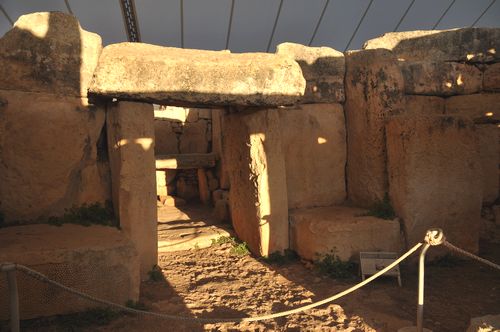
, Gozo News, Malta
In a bid to provide an enhanced experience to visitors, only 40 people will be allowed access to the temples.
Sunrise on the first day of each season underlines the relationship between the temples and celestial bodies. Although it is not known for certain whether these orientations were intentional, they are so systematic that this is very probable.
On these days the first rays of the sun light up the edge of a megalith found to the right of the central doorway connecting the first pair of chamber to the inner chamber of the Lower Mnajdra Temple.”
[Full Story]
“The Astronomical Orientation of Ancient Greek Temples”
November 23, 2009, PLoS ONE, USA
“It has long been proposed that classical temples may have been aligned with respect to sunrise on certain dates.
The idea was first proposed by Nissen in 1869. This idea was developed further by other authors such as Penrose and Dinsmoor, who argued that a temple could be dated from its astronomical alignment.
This explanation was rebutted in the 1980s by Herbert on the grounds that plenty of Greek temples did not face east.
Following a survey of Sicilian and southern Italian temples Aveni and Romano reasserted that there is an astronomical pattern to the alignment of Greek temples, but the two most recently published statements on the subject both state that there was no evidence of astronomical intent.
At best, there is no consensus about the answer, though a more accurate summary would be that opinion is shifting away from the notion of astronomical alignments being embedded within Greek temples.
The presence or lack of such alignments is an issue as it reflects upon Greek religious practice in the archaic (750–480 BC) and classical (480–323 BC) periods.
Salt and Boutsikas have proposed that Greek religious festivals, in particular Panhellenic events, may have been calibrated against the seasons using astronomical observation.
Hannah also observes that the observation of celestial bodies helped govern the cycles of Greek civic life.
The interaction of local topography, architecture and astronomy may therefore helped shape the day-to-day functioning of a city. “
[Abstract & Full Paper]
“Ancient Greek worshippers showed inclination towards the Sun”
November 19, 2009, The Times, UK
“The Ancient Greeks deliberately built their temples to face the rising Sun, according to research that promises to shed light on their religious practices and to resolve a longstanding archaeological controversy.
An investigation into temples built by Greek colonists in Sicily has found strong evidence that they were aligned to the East.
The Concordia Temple In Sicily, one of many built by the
Ancient Greeks to face the east
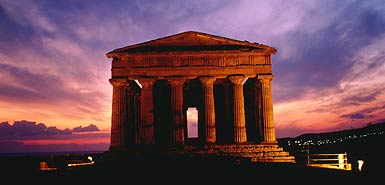
, Fuste Raga/Corbis for The Times
The findings, by Alun Salt, of the University of Leicester, suggest that Ancient Greek religion may have included ritual elements inspired by astronomy, as well as illuminating the national culture of settlers who founded communities beyond the mainland.
The study could settle a long-running dispute among archaeologists and classicists about temple orientation.
Although it has long been known that most of these shrines face east, some academics have questioned whether this alignment reflected a deliberate plan.
Critics of astronomical theories have pointed out that some temples face north, south or west, and argue that their orientation was not important to the Greeks.
Dr Salt’s research, however, indicates that the predominant east-west alignment is almost impossible to explain by chance, and probably followed a religious convention founded on astronomy.
Temples laid out in accordance with astronomical phenomena could have highlighted the role of gods and goddesses as arbiters of nature, or helped priests to interpret celestial omens. They could also have helped in observations needed to calibrate the religious calendar.”
[Full Story]
“Ohio Wesleyan art professor uncovers celestial connection
in desert Southwest”
November 01, 2009, The Columbus Dispatch, USA
“Jim Krehbiel was up past midnight making a piece of art by layering maps and field notes onto photos he had taken of an ancient ritual site high on a cliff ledge in the desert Southwest.
Why, he wondered that night in the fall of 2007, would anyone build something so important in such a remote spot among the canyons and mesas?
It was then that the chairman of Ohio Wesleyan University’s art department found himself at the conjunction of archaeology and astronomy.
Krehbiel found that the moon rises there during an event called the
major lunar standstill, which occurs every 18.6 years
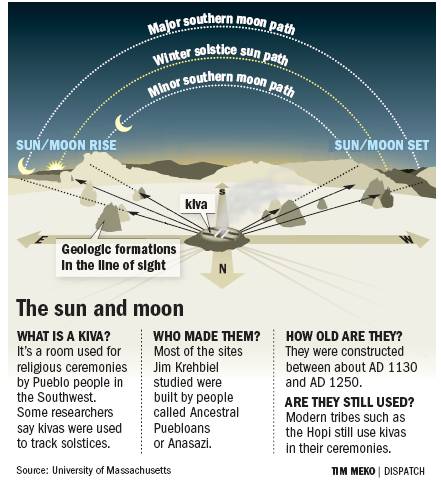
, The Columbus Dispatch
Perhaps, he thought, the site was an observatory; a place to help religious leaders keep track of the solstices, time rituals and plantings.
‘Their world around them is absolute, total chaos’, Krehbiel said. ‘They were really at the mercy of the elements. So where do they go for something that’s predictable, that remains the same, that you can count on: The sky and the relationship of those things on the horizon.’.
Krehbiel was stepping into archeo-astronomy, the study of the ways ancient cultures tracked the sky’s movements. The science has been gaining acceptance as a branch of archaeology since the 1970s.
England’s Stonehenge, for example, is well known for its alignments with astronomical phenomena. In Ohio, archaeologists agree that ancient mound builders lined up some works with the movements of the sun and the moon.
In the Southwest, the most famous site is the Chaco Sun Dagger. The sun and moon shine through the spaces between slabs of rock to make slashes of light on a spiral carving in conjunction with the solstices and the movements of the moon.
‘We went back out in October of 2008 and re-examined the sites’, Krehbiel said. ‘We had the spherical trig charts in hand, and everything just fell into place.’. They have found alignments for solstices, equinoxes and major and minor lunar standstills at 29 sites so far.”
[Full Story]
“The mysteries of La Hougue Bie”
October 12, 2009, BBC Jersey, Channel Islands
“The 6,000 year-old burial site at La Hougue Bie is one of the best preserved remnants of the Neolithic period in Western Europe. Every spring and autumn crowds of people gather to watch the equinox from inside the chamber.
Archaeologist Olga Finch is the curator at La Hougue Bie, and explained this in more detail.
Every spring and autumn crowds gather to watch the
equinox sunrise from inside the chamber
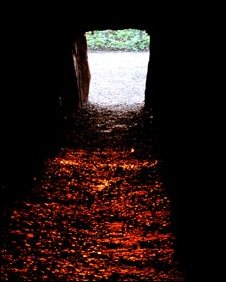
, BBC News
‘We know there were rituals associated with seasonal activities because the Neolithic people were the first farmers’, she explained.
Therefore the cycles of nature were crucial to the survival of the indigenous population. The discovery of the equinox alignment brought home how important this time of year was to the farming community.
The Equinox alignment happens twice a year. La Hougue Bie’s entrance points directly east, which enables a beam of sunlight to travel up the passageway to illuminate the chamber deep in the mound.
‘We are talking about 6,000 years ago. The window into the tomb was set up perfectly, so that the rising sun penetrates not just the front, but all the way back into the terminal cell’, she said.”
[Full Story]
“North America comet theory questioned”
October 12, 2009, Nature, UK
“An independent study has cast more doubt on a controversial theory that a comet exploded over icy North America nearly 13,000 years ago, wiping out the Clovis people and many of the continent’s large animals.
Archaeologists have examined sediments at seven Clovis-age sites across the United States, and did not find enough magnetic cosmic debris to confirm that an extraterrestrial impact happened at that time, says the report in the Proceedings of the National Academy of Sciences (PNAS).
Sediments at the San Jon site, in eastern New Mexico, contained very low abundances of magnetic spherules said to be evidence of an impact
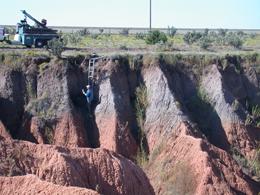
, Vance Holliday / Nature
It is the latest of several studies unable to support aspects of the impact hypothesis.
In 2007, a team led by Californian researchers announced a theory2 that a comet or asteroid had exploded over the North American ice sheet, creating widespread fire and an atmospheric soot burst followed by a cooling period known as the Younger Dryas.
Sometime after this, the Clovis people, sophisticated large-animal hunters known for their spear points, mysteriously disappeared; the team linked their vanishing to the environmental effects of the proposed impact.”
[Full Story]
“Emperor Nero’s Revolving Banqueting Room
Discovered in Rome”
September 30, 2009, Novinite, Bulgaria
“Archaeologists have discovered what they believe to be the remains of Nero’s dining hall.
While excavating the Domus Aurea, or Golden House, built for the emperor on the Palatine Hill in Rome, they discovered part of a circular room supported by a pillar with a diameter of more than 13 feet (4 meters).
The newly-excavated revolving banqueting hall of Roman Emperor Nero.
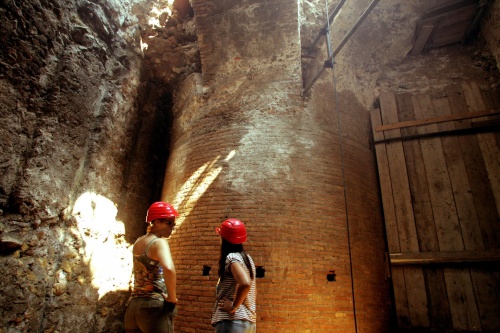
, EPA / Novinite, Bulgaria
The hall is said to have had a revolving wooden floor which allowed guests to survey a ceiling painted with stars and equipped with panels from which flower petals and perfume would shower onto the tables below.
Suetonius, the Roman historian, described the unique revolving room in his Lives of the Caesars, written some 60 years after Nero’s death.
‘The chief banqueting room was circular and revolved perpetually, night and day, in imitation of the motion of the celestial bodies’, he wrote.”
[Full Story]
“Expert to speak on historical technology in Lichfield”
September 21, 2009, The Lichfield Blog, England
“The subject of recent research raising questions about the history of technology set to be examined by a leading expert at a talk in Lichfield.
Professor Mike Edmunds from Cardiff University’s The Science and Technology Facilities Council will be delivering his lecture on The Antikythera Mechanism to the Lichfield Science & Engineering Society (LSES) at the Lichfield Garrick Studio on October 14 at 8pm.
Part of the Antikythera Mechanism
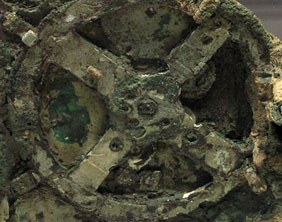
, The Lichfield Blog
What may well be the most extraordinary surviving artefact from the ancient Greek world was discovered just over a century ago.
In 1900, sponge divers off the coast of the Mediterranean island of Antikythera found a wreck which was to yield a device containing over thirty gear wheels dating from the 1st century BC and now known as the Antikythera Mechanism.
Entry to the talk is £4 for visitors, free for students and members of the Lichfield Science & Engineering Society, the Burton-upon-Trent and District Engineering Society and the Stoke-on-Trent Association of Engineers. Tickets are not available in advance and can only be purchased on the door.”
[Full Story]
“Exact Date Pinned to Great Pyramid’s Construction?”
September 21, 2009, Brisbane Times, Australia
“The Egyptians started building the Great Pyramid of Giza on August 23, 2470 B.C., according to controversial new research that attempts to place an exact date on the start of the ancient construction project.
A team of Egyptian researchers arrived at the date based on calculations of historical appearances of the star Sothis—today called Sirius.
Construction of the Great Pyramid (right), the tomb of the pharaoh Khufu,
started on August 23, 2470 B.C., according to controversial
new research announced in August 2009.
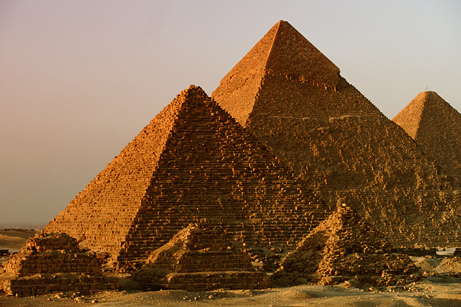
, Kenneth Garrett/NGS for NatGeo News
Every year around the time of the Nile River floods, Sothis would rise in the early morning sky after a long absence.
‘The appearance of this star indicates the beginning of an inundation period’ for the Nile, said team leader Abdel-Halim Nur El-Din, former head of Egypt’s Supreme Council of Antiquities.
‘Throughout their history, “Egyptians … started their main buildings, the tombs, and the temples at the beginning of the inundation’ — an auspicious time, since floodwaters brought fresh soil, maintaining the region’s fertility.
In addition, pharaohs always started building their tombs at the starts of their rules. Khufu, the pharaoh meant to be buried in the Great Pyramid, took power in 2470 B.C., according to Nur El-Din and colleagues.
The researchers therefore compared the modern calendar, the ancient Egyptian calendar, and the cycle of the star to find the exact day Sothis would have appeared that year.”
[Full Story]
“A ship of stones”
September 21, 2009, Brisbane Times, Australia
“The serious photographers were here at dawn, capturing the silhouettes as the sun rose from the sea beyond. We’ve missed that moment but there is still plenty of magic hovering around the Ales Stenar.
It’s the mystery surrounding these prehistoric stone circles that appeals to us.
We can imagine they were erected with great difficulty, massive boulders being dragged across country and up a steep hill, then carefully aligned with the heavens and set on end.
But the purpose of all that effort remains unknown and even scholars can only make guesses.
Stern view … the standing stones of Ales Stenar in Sweden
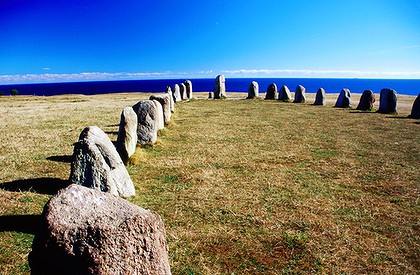
, Dennis Johnson/Lonely Planet
A collection of 59 standing stones, each from one to three metres high, the Ales Stenar (or Ale’s Stones) rise from a field on a coastal ridge in southern Sweden’s Osterlen district, above the arty-crafty town of Kaseberga.
They’re arranged in the rough shape of a ship, 67-metres long, with taller stones at the prow and stern.
The Ales Stenar are thought to date from the time of the Vikings, about AD600-AD1000.
At summer solstice the sun sets precisely over the prow stone and at winter solstice rises over the ship’s stern.”
[Full Story]
[This ancient megalithic structure would mark the rising of the ‘Mabyn’, the new-born Sun, born out of the virgin sea on the day AFTER the Winter Solstice, when the Sun begins to rise higher in the sky each day until the Summer Solstice, after which it rises lower each day until the next Winter Solstice.
This terrestrial-celestial cycle was at the core of Druidic beliefs in northwest Europe in ancient times, and was researched and recorded for posterity by Welsh prehistorian and Druid, Owen ‘Morien’ Morgan, in the late 19th century.
In Wales in ancient times, Owen ‘Morien’ Morgan found that anyone who observes the new-born Sun rising out of the virgin sea could then adopt the Druidic title of ‘Morien’.
You can find out more about this essence of Druidic belief, practice and lore in his books
“The Mabin of the Mabinogion” and
“Light of Britannia” – Ed.]
“Egyptian temples followed heavenly plans”
September 08, 2009, New Scientist, UK
“Ancient Egyptian temples were aligned so precisely with astronomical events that people could set their political, economic and religious calendars by them.
So finds a study of 650 temples, some dating back to 3000 BC.
The Karnak temple in Luxor was laid out to
coordinate with astronomical events
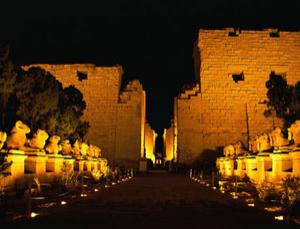
, Hisham Ibrahim for New Scientist
For example, New Year coincided with the moment that the winter-solstice sun hit the central sanctuary of the Karnak temple (pictured) in present-day Luxor, says archaeological astronomer Juan Belmonte of the Canaries Astrophysical Institute in Tenerife, Spain.
Hieroglyphs on temple walls have hinted at the use of astronomy in temple architecture, including depictions of the ‘stretching of the cord’ ceremony in which the pharaoh marked out the alignment for the temple with string.
But there had been little evidence to support the drawings.
Belmonte and Mosalam Shaltout of the Helwan Observatory in Cairo found that the temples are all aligned according to an astronomically significant event, such as a solstice or equinox, or the rising of Sirius, the brightest star in the sky”
[Full Story]
[The paper referred to in the above article originated in the journal “Advances in Space Research”. The title of the paper is: “Keeping Ma’at: an astronomical approach to the orientation of the temples in ancient Egypt”. The authors commented on the purpose of their research:]
“The aim is to find a correct and almost definitive answer to the question of whether the ancient Egyptian sacred constructions were astronomically aligned or not. Our data seem to answer this question in the affirmative sense. Besides, they offer a very interesting new perspective in the field of landscape archaeology, a new discipline hardly worked in Egypt so far, in which terrestrial landscape, dominated by the Nile, and celestial landscape, dominated by the sun and the stars, would combine in order to permit the establishment of Ma’at, the Cosmic Order, on Earth.”
The concept of a cosmic order on earth which accurately, and proportionately, reflected the heavens is common to most ancient cultures throughout the world. The further back you go in time the more accurate is seems to be – Ed.]
“Stone inscription on solar eclipse found”
July 21, 2009, Express Buzz, India
“Archaeologists have found a stone inscription at Periyanayaki Amman temple in Palani dating back to 17th century that mentions a solar eclipse that took place at that time.
Periyanayaki Amman temple is one of the important satellite shrines of Arulmighu Dhandayuthapani Swamy temple in Palani.
A portion of stone inscription at Periyanayaki Amman temple in Palani
which mentions a solar eclipse during 17th century.
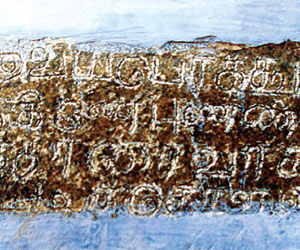
, Express Buzz, India
This temple was constructed in the 14th century by the Pandiya kings, who worshipped Lord Shiva. After its destruction by Malik Kafur, the Nayakkar dynasty built a shrine for Amman at the same site.
Archaeologist Narayanamoorthy, architect Manivannan and professors of history from women’s college conducted research in the temple when they stumbled upon a stone inscription on the wall of the ‘yaga sala’, that mentions solar eclipse.
Only four lines of the inscription are now visible, as all other lines had been obliterated over a period of time.”
[Full Story]
“Chimney Rock: Chaco or not?”
July 10, 2009, The Durango Herald, USA
“After a hiatus of more than three decades, archaeologists once again are conducting excavations on the Great House Pueblo high atop a knife-edge mesa at Chimney Rock Archaeological Area in the San Juan National Forest.
What they’re finding may help explain the significance of the nearly thousand-year-old structure.
‘It’s a chance to have a new look at this site, because archaeology has really advanced in the last few decades’, said San Juan National Forest Archaeologist Julie Coleman.
One of the site’s claims to fame is its possible tie to the major lunar standstill, an astronomical phenomenon marking the end of the moon’s northern migration cycle.
Every 18.6 years from the vantage point of the Great House, the moon will rise within a narrow window of sky framed by the giant rock spires that give Chimney Rock its name.
The most recent lunar standstill took place from 2004 to 2008. The next opportunity to view a major lunar standstill at Chimney Rock will not take place until about 2022.
Earlier research at Chimney Rock conducted by Kim Malville, professor of astrophysical, planetary and atmospheric sciences at the University of Colorado, proposes that periods of construction at the Great House corresponded with the dates of historic lunar standstills.
‘Based on research from the 1970s, we do think it was constructed in time for the major lunar standstill in 1076, and we think it was rebuilt in time for the next lunar standstill in the 1090s’, Coleman said.”
[Full Story]
“Triple eclipse, a precursor to calamity?”
July 01, 2009, The Times of India, India
“‘We have a triple eclipse coming up within a month and through archaeo-astronomy, using planetarium software, we found that this rare astronomical phenomenon occurred twice in ancient times and they were two most traumatic periods. It set us wondering if there is a probability of a major catastrophe awaiting us now’, said Bharath Gyan conceptualiser D K Hari on Tuesday.
Bharath Gyan, an initiative of Hari and his wife, has been collating information about India using ancient knowledge sources and modern scientific tools and methods.
It has 400-500 hours of content, compiled in capsules on various subjects.
Hari talked about the triple eclipses in 3067 BC and again in 3031 BC and the corresponding historical upheavals.
‘With the advancement of modern science and technology we are able to date these two triple eclipses and accord dates to the events of the Mahabharata and correlate them with the events that occurred in the rest of the world.’
‘Occurrences of many of these triple eclipses have coincided with some of the major catastrophes that mankind has experienced. Those that have changed the course of civilization! Is this a mere coincidence or do triple eclipses influence the course of civilization’, asks Hari.”
[Full Story]
“See solar calendars in Petrified National Forest”
June 20, 2009, East Valley Tribune, USA
“Solar calendars have been discovered throughout the Southwest marking the summer and winter solstice and the equinoxes.
In Arizona, nowhere is the evidence more visual then at The Petrified National Forest outside of Holbrook, where solar calendars were used by ancient civilizations to plan their seasons.
Around the world, cultures have been fascinated with the passage of the seasons and movements of the sun and moon, creating such places as Stonehenge in the United Kingdom, Carnac Stones of France, and Uxmal in the Yucatan.
For several thousand years, the prehistoric people of the Southwest have made their own versions of these ancient calendars.
Solar calendars are petroglyphs which interact with sunlight and shadow as the sun moves across the sky to mark the passage of the seasons.
Starting today and continuing daily from 8:30 a.m. to 9:30 a.m. through June 28, to U.S. Forest Rangers at Puerco Pueblo in the Petrified National Forest will help visitors watch an ancient solar calendar – which peaks about 9 a.m. each morning – as part of the park’s Summer Solstice Celebration.”
[Full Story]
“Iron Period layers”
June 06, 2009, Zee News, India
“The latest archaeological research at the ancient observatory of Kokino in north-eastern Macedonia has revealed layers from the Iron Period, around the seventh century BC.
The Kokino archaeological site, which Macedonia aims to have included on the UNESCO’s World Heritage list, is located about 30 kilometers from the town of Kumanovo in north-eastern Macedonia.
The megalithic observatory discovered there in 2001 was determined to be around 3,800 years old.
Stone markers used to track the movement of Sun and Moon were also discovered at the site.”
[Full Story]
“Hope for a common date for Easter affirmed again”
May 29, 2009, Ekklesia, UK
“The hope that all Christians will be able to celebrate Easter on the same day in the future has been reaffirmed by an international ecumenical seminar organized by the Institute of Ecumenical Studies at the Ukrainian Catholic University in Lviv.
The problem is almost as old as the church itself. As Christianity started to spread around the world, Christians came to hold differing opinions on when to commemorate Jesus Christ’s death and resurrection, due to the different reports in the four gospels on these events.
Attempts to establish a common date for Easter began with the Council of Nicaea in the year 325. It established that the date of Easter would be the first Sunday after the full moon following the vernal equinox.
However, it did not fix the methods to be used to calculate the timing of the full moon or the vernal equinox.
Nowadays the Orthodox churches use the 21 March of the Julian calendar as the date of the equinox, while the churches of the Western tradition – that is the Protestant and Catholic churches – base their calculations on the Gregorian calendar. The resulting gap between the two Easter dates can be as much as five weeks.
All participants at the seminar in Lviv, which included Orthodox, Roman Catholic and Protestant theologians from a variety of European countries, endorsed a compromise proposed at a World Council of Churches (WCC) consultation in Aleppo, Syria, in 1997.
The proposal was to keep the Nicaea rule but calculate the equinox and full moon using the accurate astronomical data available today, rather than those used many years ago.”
[Full Story]
“Inventory of Prehispanic Sites with Astronomical Value Created”
May 28, 2009, INAH, Mexico
“To celebrate the International Year of Astronomy, the United Nations Educational, Scientific and Cultural Organization (UNESCO) prepares a data base of Prehispanic sites and living manifestations with astronomic and archaeoastronomical value, inscribed or not in the World Heritage List.
The Americas inventory will be coordinated by Dr Stanislaw Iwaniszewski, part of the National Institute of Anthropology and History (INAH).
Iwaniszewski, academic at the National School of Anthropology and History (ENAH), is an acknowledged Mesoamerican archaeoastronomy researcher, author of several books and articles published in international journals.
The specialist announced that between January and April 2009, arrangements have been made between UNESCO, the International Council on Monuments and Sites (ICOMOS), and the International Astronomical Union (IAU) to incorporate a group of experts that would be divided in 14 sections according to geographical areas and chronology.
Regarding the Americas, ‘we have to make a detailed catalogue of cultural goods related to evidence of astronomical activities of Amerindian peoples, before European colonization’, he mentioned.
Each registration form must include a general description of the site, its cultural affiliation and chronology, an archaeoastronomical evaluation (describing the level of astronomical knowledge reached by the creators of such spaces) and bibliography related to the theme.”
[Full Story]
“Rare blooms, ancient calendars found along local landscape”
April 26, 2009, FDL Reporter, USA
“Imagine if a fragment of an ancient trail — a pathway that served as a cross-continental corridor for ancient people — ran through your backyard.
Along this aboriginal byway are shamans’ markers, petroforms, effigy mounds in the shapes of creatures, eerie stone faces and astronomic alignments probably dating to the Archaic epoch, as long ago as 5,000 years.
Now picture a state highway running through the pristine land, its mid-point bisecting the largest effigy mound sloping up from the earth in the shape of a 90-foot-long quadruped.
‘The swath they would cut is 400 feet wide. That’s what we’re fighting to preserve right now’, said University of Wisconsin-Oshkosh and Ripon College Professor Jack Steinbring, a member of the Mid-American Geographic Foundation.
‘The inability of the plow to scale the 160-foot limestone cliffs is what has preserved these ancient treasures’, said Dwight Weiser, who has lived at the foot of the Ledge for 40 years and is principal MAGF investigator at sites in Eden and Empire townships.
The effigy, conical and lineal mounds of the region are first mentioned in a 1915 edition of Wisconsin Archeologist, and written about by archeologist William Titus, who explored Fond du Lac County when vast grasslands and prairie were still in place.
He describes the area as ‘a field of great activity among the prehistoric tribes of Wisconsin. The lake (Winnebago) together with the Upper and Lower Fox rivers and numerous smaller streams, opened up to primitive navigation and commerce, a vast area, all of which were occupied… by different tribes at different periods.’
Weiser, who describes himself as an advocational archeologist, is particularly interested in studying the astronomical arrangement of petroforms (patterns of rocks on the open ground) that line up with stars, marking the summer and winter solstice.
He said there are at least five major archeological sites where stone circles are laid out and stone lines go on for miles.”
[Full Story]
“‘Woodhenge’ found in Hill of Tara’s soil”
April 12, 2009, The Sunday Times, UK
“Ireland’s ‘Stonehenge’, a 4,500-year-old structure at the Hill of Tara in Co Meath, has been re-created by archeologists and computer-graphics experts.
Underground remains of the structure were discovered by soil x-rays of the hill, which has been at the centre of an international dispute because of its proximity to the new M3 motorway.
The model, to be shown on an RTE television documentary this week, was created using information gathered from studying a ditch, six metres wide and three deep, cut into the bedrock of the hill and enclosing the Mound of Hostages, an ancient passage tomb.
The TV documentary features cutting-edge computer-generated images of what the ancient Irish monument might have looked like, based on archaeological evidence from the site
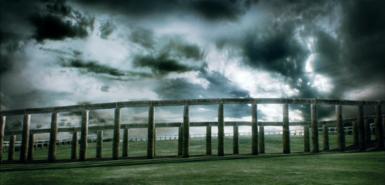
, The Sunday Times, UK
Robert Vance, a historian who worked on the two-part RTE series, entitled Secrets of the Stones — Decoding Ireland’s Lost Past, and the author of an accompanying book of the same name, said there are a number of theories about what the wooden henge was used for.
Using high-definition, computer-generated imagery, a vision of the circular arena at the Hill of Tara was created for the documentary. It posits catastrophic events 4,000 years ago may have caused a change in our ancestors’ beliefs.
At around this time, there is evidence Ireland’s passage tombs were abandoned in favour of ‘new monuments and new gods’ and people were never buried in them again. One theory is that a long spell of bad weather could have led people to change their beliefs.
Using high-definition, computer-generated imagery, a vision of the circular arena at the Hill of Tara was created for the documentary. It posits catastrophic events 4,000 years ago may have caused a change in our ancestors’ beliefs.
According to studies of ancient trees preserved in Ireland’s bogs, a growth pause caused by climate change occurred at this time, suggesting that some catastrophic event might have left people in fear.
Another theory is that a volcano in the 6th century may have frightened pagan Celts Celts into believing in ‘new’ gods because of the weather changes caused when the dust reflected light and heat away from the Earth.
Vance believes, however, that the event that led people to change their beliefs was more likely a comet during the Bronze Age, which partly disintegrated and sent fireballs and flaming debris across the sky.
‘We see such comet debris as shooting stars in the night sky. To our ancestors, these were terrifying heavenly signs’, he said.
The comet would also have triggered a dust veil that caused temperatures to plunge. ‘The old-style temples like Newgrange weren’t powerful enough to compete with this new object in the sky’, according to the documentary.”
[Full Story]
“UNESCO asked to consider Jantar Mantars as heritage sites”
March 25, 2009, The Hindu, India
“Measuring time for the past three centuries, five Jantar Mantars in the country could add more feathers to their cap if UNESCO accepts India’s proposal to accord World Heritage status to them.
The Archaeological Survey of India (ASI) has identified five astronomical observatories in Delhi, Jaipur, Varanasi, Ujjain and Mathura as significant heritage structures and has recommended to the UNESCO to declare them as World Heritage Sites in this year’s serial nominations.
Constructed between 1727 and 1734 by Maharajah Jai Singh II of Jaipur, the five astronomical observatories incorporate multiple buildings of unique form, each with a specialised function for astronomical measurement.
These structures with their striking combinations of geometric forms at large scale, have captivated the attention of architects, artists, and art historians worldwide.”
[Full Story]
“Giza Pyramids Align Toward City of Sun God”
March 24, 2009, Discovery Channel News, USA
“Some of Egypt’s most magnificent pyramids were deliberately designed to follow a pattern of invisible diagonal lines, an Italian study has concluded.
According to Giulio Magli, professor of archaeoastronomy at Milan’s Polytechnic University, these invisible lines would connect most of the funerary complexes raised by the kings of the Old Kingdom between 2630 and 2323 B.C.
‘Following these diagonals, it appears clear that the arrangement of the monuments was carefully chosen in order to satisfy a number of criteria, which include dynastic lineage, religion and astronomical alignments’, Magli told Discovery News.
Our starting point was the so-called ‘Giza diagonal,’ an ideal line which connects the southeast corners of the three main pyramids and points to Heliopolis. This was an important religious center sacred to the sun god’, Magli said.
The northwest corners of three chronologically successive pyramids in Abu Sir — those identified with the tombs of Sahure, Neferirkare and Neferefre — align on a diagonal similar to that of Giza, said Magli..
He found that the Abu Rawash, Giza, and Abu Sir diagonals point to three stars — Sirius, Crux-Centaurus, and Canopus, respectively. These stars sat in alignment over the pyramids when viewed from Heliopolis.”
[Full Story]
“The Pantheon a sundial?”
March 10, 2009, The Roman Forum, Italy
“Scientists believe the Pantheon may have acted as a colossal ancient timekeeping device after an expert observed changes in the paths of light beaming through the empty space, or oculus, in its domed ceiling.
The Pantheon
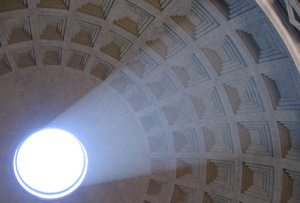
, The Roman Forum, Italy
Scholar Robert Hannah of the University of Otago in Dunedin, New Zealand made the discovery while visiting the Pantheon in 2005, while researching for a book on time in antiquity.
According to a report in the New Scientist, he observed that during the six months of winter, the light of the noon sun traces a path across the inside of the roof. During summer however, with the sun higher in the sky, the shaft shines onto the lower walls and floor.
At the two equinoxes, in March and September, the light hits the junction between the roof and wall, above the Pantheon’s principal northern doorway, where a panel allows a sliver of light through to the shadowed front courtyard – the only moment in the year that it normally sees sunlight if the main doors are closed.”
[Full Story]
“The sky at night, as charted in the 7th century”
March 07, 2009, The Times, UK
“The world’s earliest astronomical chart is 300 years older than previously believed, according to research by the British Library.
The chart was among 40,000 ancient documents found in a cave in Dunhuang, China, a trove compared with the discovery of the Dead Sea Scrolls.
t has now been conclusively dated to the 7th century AD. It was among tens of thousands of objects acquired in China by Sir Marc Aurel Stein, the British adventurer
The map, 6ft 5in (1.98m) long, charts the positions of 1,339 stars and was acquired by the British Library from Sir Auriel. “
[Full Story]
“Ancient supernovae may be recorded in Antarctic ice”
March 03, 2009, New Scientist, UK
“A newly examined ice core shows what may be the chemical traces of supernovae that exploded a thousand years ago.
Yuko Motizuki of the RIKEN research institute in Wako, Japan, and colleagues analysed the nitrate content of an ice core drilled at Dome Fuji station in Antarctica. Nitrate is produced in the atmosphere by nitrogen oxides, which in turn should be created by the gamma radiation from a supernova.
Motizuki’s group found high nitrate concentrations in three thin layers about 50 metres deep. Because snow gradually builds up into layers of ice, depth indicates age.
After calibrating this icy calendar using chemical markers laid down by known volcanic eruptions, the team found that one nitrate spike is close to the year 1054, when Chinese observers saw a bright supernova. That explosion left behind the Crab Nebula and pulsar. Another spike is close to 1006, the year of an even brighter supernova.
The third nitrate spike is around the year 1060, when no supernova was reported. The authors suggest that it might be the result of a supernova in the less-well observed southern hemisphere or one that was hidden behind a dark interstellar cloud and therefore went unnoticed.”
[Full Story]
“Archaeology Awareness”
March 03, 2009, The CV Bugle, USA
“Combine the fact that March is Archaeology and Heritage Awareness Month and that few places in the state are as rich in reminders of the past than the Verde Valley and you have cause for celebration.
Which is precisely what Arizona State Parks, Verde Valley Chapter of the Arizona Archaeological Society Arizona, Coconino National Forest and the National Park Service are planning to do.
All four will be sponsoring events throughout the month and throughout the valley, designed to bring awareness and appreciation of the valley’s past.
Ken Zoll, president of the Verde Valley Chapter of the Arizona Archaeological Society and amateur archaeoastronomer will sponsor a hike to visit the V Bar V Heritage Site’s solar calendar, as the sun dagger appears during the vernal equinox. “
[Full Story]
“Galileo Four centuries ago this year, he put us in our place”
March 01, 2009, The News Tribune, USA
“The revolution was not his alone. The idea was actually an ancient one, and other scientists had embraced it along the way. But it took Galileo and the telescope he built to prove the truth to the masses: Earth is not the center of the universe.
Galileo

, The News Tribune, USA
This year marks the 400th anniversary of the year Galileo turned his first crude telescope to the heavens. Through it, he observed spots on the sun and shadow patterns proving that the moon had mountains and valleys.
These visible ‘imperfections’ helped overturn thousands of years of traditional belief that everything in the heavens must be smooth, perfect and unchanging.
Galileo also watched Venus over many months, observing phases that proved it was actually orbiting the sun and not, as previously had been believed, orbiting Earth. He observed Jupiter night after night, discovering that it was always accompanied by four ‘stars’ that clearly orbited the planet.
We now know these ‘stars’ to be Jupiter’s four largest moons, and their existence offered definitive proof that Earth was not the center of everything.
There are over 200 stones on the seven-hectare site and many of the stones have smooth angled holes in them, directed at different points in the sky, leading scientists to believe it is the world’s oldest observatory, dating back 7500 years.”
[Full Story]
[It is generally accepted that the science of astronomy developed out of the archaic science of astrology. The peoples of the ancient world observed the cycles in the sky AS SEEN FROM THE EARTH, and over countless generations developed a vast body of knowledge about the “correspondences” between cyclical events in the heavens, and cyclical events in which they observed in their natural surroundings.
Such “correspondences” included, for example, the “peak” times of the in-migration of species of fish such as salmonids; the “peak” times of the “bud breaks”, “blossomings” and “fruit-ripe” events of countless species of plants which provided them with fruits, nuts and berries on a “predictable” annual basis, as well as the annual migrations of vast herds of other species such as reindeer, caribou, buffalo etc., on which they depended for sustenance.
Following a series of celestial bombardments from asteroids and cometary debris during the past 20,000 years, which devastated any and all levels of “civilisation” in the archaic world, much if not all of this knowledge was lost, and the little that was remembered deteriorated over time into the state of superstitious astrology that existed approximately 2,000 years ago.
While Galileo helped to bring us away from that state of superstitious astrology by showing that the Earth was not the centre of the solar system, the “modern science” that has developed since his time has contributed to the virtual exinction of almost the whole body of knowledge which made up the archaic science of “celestial-terrestrial correspondences” that remains now only in the small pockets of tribal peoples in remote areas of the world.
But those involved with the developing sciences of chronobiology and cosmoclimatology are beginning to realise that there is much, much more to the archaic science of correspondences than 20th century “modern science” was prepared to acknowledge. Watch this space……….. Ed.]
“Retired U of A prof authors book on AB Stonehenge”
February 26, 2009, The Gateway, Canada
“A former University of Alberta chemistry professor is challenging conventional wisdom on Canada’s archaeological history by claiming that a seemingly ordinary site in southern Alberta is really a vast, open-air sun temple with a 5000-year-old calendar predating that of England’s Stonehenge.
Mainstream archaeology considers the Majorville Medicine Wheel—located about 70km east of Calgary—to be just another spiritual monument left behind by early aboriginals.
But a new book by U of A professor emeritus Gordon Freeman argues that the wheel is in fact the centre of a 26-square-kilometre stone lacework that predicts the changing seasons with greater accuracy than the modern Gregorian calendar.
‘Genius existed on the prairies 5000 years ago’, he said of the early Plains Indians who laid down the temple.
The rock-encircled cairn—which resembles a wheel with spokes—had been partially excavated in 1972, and was dated at about 5000 years old. But as he approached it, Freeman noticed something more intriguing lying beyond the wheel.
‘Walking up the hill […] we saw patterns all over the place, and I photographed them along with the medicine wheel. In those original photographs there’s hardly anything of the wheel itself’, he recalled.
When archaeologists told Freeman that the outlying rocks in which he’d detected these patterns were merely dropped by retreating glaciers, he knew he’d found his hobby.
After years of carefully photographing the site in all seasons and weather, noting how the rock arrangements coincided with the recurring patterns of the sun and the moon, he found that the rocks in fact mark the progression of the year with greater insight than our own calendar.
The rising and setting of the sun on the longest and shortest days of the year line up precisely with V-shaped formations found in the temple’s far-flung rock arrangements. The lines, Freeman says, are long and extremely accurate, measurable on the same date of any given year to a 20th of a degree.”
[Full Story]
“Armenian links to Stonehenge explored”
February 09, 2009, Salisbury Journal, England
“THE story of Stonehenge and the mystery that surrounds it is familiar to most Salisbury residents, but one man has come to the city to tell people about an ancient circle of standing stones which pre-dates even Wiltshire’s World Heritage site.
Carahunge
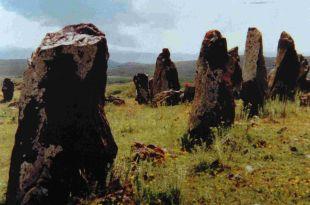
, Salisbury Journal, England
Vardan Levoni Tadevosyan is an Armenian/Spanish historian of the occult who visited Salisbury last week to raise the profile of Carahunge, dubbed the Armenian Stonehenge.
He said: ‘It’s a very important monument, not just for Armenia, but for the whole world.’
Carahunge, meaning ‘speaking stones’, is located 200km from the Armenian capital Yerevan, near a town called Sisian.
There are over 200 stones on the seven-hectare site and many of the stones have smooth angled holes in them, directed at different points in the sky, leading scientists to believe it is the world’s oldest observatory, dating back 7500 years.”
[Full Story]
“5000 year old solar calendar in Canada!”
February 06, 2009, BeliefNet, USA
“An academic maverick is challenging conventional wisdom on Canada’s prehistory by claiming an archeological site in southern Alberta is really a vast, open-air sun temple with a precise 5,000-year-old calendar predating England’s Stonehenge and Egypt’s pyramids.
the ancient calendar site in southern Alberta, Canada
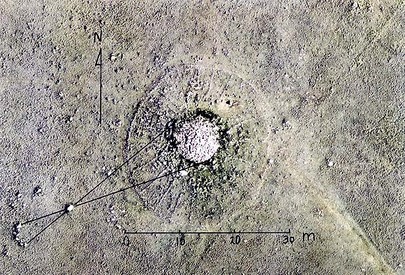
, BeliefNet, USA
Mainstream archeologists consider the rock-encircled cairn to be just another medicine wheel left behind by early aboriginals. But a new book by retired University of Alberta professor Gordon Freeman says it is in fact the centre of a 26-square-kilometre stone ‘lacework’ that marks the changing seasons and the phases of the moon with greater accuracy than our current calendar.
‘Genius existed on the prairies 5,000 years ago’, says Freeman, the widely published former head of the university’s physical and theoretical chemistry department.”
[Full Story]
“Canada’s Stonehenge: scientist says Alberta sun temple
has 5,000-year-old calendar”
January 30, 2009, The Canadian Press, Canada
“An academic maverick is challenging conventional wisdom on Canada’s prehistory by claiming an archeological site in southern Alberta is really a vast, open-air sun temple with a precise 5,000-year-old calendar predating England’s Stonehenge and Egypt’s pyramids.
Mainstream archeologists consider the rock-encircled cairn to be just another medicine wheel left behind by early aboriginals.
But a new book by retired University of Alberta professor Gordon Freeman says it is in fact the centre of a 26-square-kilometre stone ‘lacework’ that marks the changing seasons and the phases of the moon with greater accuracy than our current calendar.
These discoveries are carefully documented and interpreted in Gordon Freeman’s new book, Canada’s Stonehenge: Astounding Archaeological Discoveries in Canada, England, and Wales, launching February 4th.
‘Genius existed on the prairies 5,000 years ago’, says Freeman, the widely published former head of the university’s physical and theoretical chemistry department.
‘As we walked toward the hilltop, I saw all kinds of patterns in the rocks on the way up. As I walked around the hilltop, I could see patterns that I doubted very much were accidental.’
Freeman photographed what he saw and showed the images to archeologists. They told him the rocks, some of which weigh up to a tonne, had been randomly distributed by melting glaciers. But those rocks and rock piles, Freeman said, had been ‘highly engineered’, shimmied and balanced and wedged in ways he couldn’t believe were natural.
And so began a magnificent obsession – 28 years of photographing the site in summer and winter, observing the alignment of rocks and how they coincided with the recurring patterns of sun, moon and stars.”
[Full Story]
“Is the Roman Pantheon a colossal sundial?”
January 28, 2009, New Scientist, UK
“Has the grand Roman Pantheon been keeping a secret for nearly 2000 years? An expert in ancient timekeeping thinks so, arguing that it acts as a colossal sundial.
The imposing temple in Rome, completed in AD 128, is one of the most impressive buildings that survives from antiquity.
It consists of a cylindrical chamber topped by a domed roof with an oculus in the top which lets through a dramatic shaft of sunlight. It boasts a colonnaded courtyard at the front.
Only at noon on an equinox does the sun shine on the Pantheon’s oculus
at the perfect angle to pass through a grille above the closed door
and light up the front courtyard
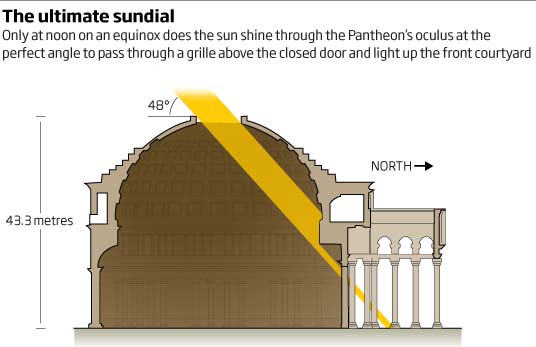
, New Scientist, UK
During the six months of winter, the light of the noon sun traces a path across the inside of the domed roof. During summer, with the sun higher in the sky, the shaft shines onto the lower walls and floor.
At the two equinoxes, in March and September, the sunlight coming in through the hole strikes the junction between the roof and wall, above the Pantheon’s grand northern doorway (pictured).
A grille above the door allows a sliver of light through to the front courtyard – the only moment in the year that it sees sunlight if its main doors are closed (see diagram).
Hannah reckons this is no coincidence. A hollowed-out hemisphere with a hole in the top was a type of sundial used in Roman times, albeit on a much smaller scale, to show the time of year.
While the Pantheon’s dome is quite flat on the outside, it forms a perfect hemisphere inside. ‘This is quite a deliberate design feature’, says Hannah.”
[Full Story]
“Science Tracer Bullets Online: Archaeoastronomy”
January 26, 2009, Library of Congress, USA
“Many prehistoric and ancient civilizations have left evidence of interest in astronomy but not all have left written records. Some of the archaeological evidence exists in the form of large architectural structures and monuments, some in the form of intricate diagrams and carvings.
While historians of astronomy focus on the technical mathematical astronomy texts of the past, the written records, archaeoastronomers emphasize other cultural expressions in tombs, iconography, ritual, ceremony, and agricultural patterns.
Archaeoastronomy is the interdisciplinary study of prehistoric, ancient, and traditional astronomies within their cultural context.
Its sources include both written and archaeological remains and it embraces calendrics, practical observation, sky lore, celestial myth, and more. Its true scope establishes it as an ‘anthropology of astronomy’.
This guide is intended to provide a selection of resources on archaeoastronomy; it is, as the name of the series implies, intended to get the reader ‘on target’. The online version may be found at: http://www.loc.gov/rr/scitech/tracer-bullets/tbs.html“
[Full Story]
[This is one of the best resources we have found on the web, and is a great introduction to astro-archaeology and archaeoastronomy for beginners, as well being a useful resource for academics. Ed.]
“Canada’s Stonehenge Discovered”
January 07, 2009, Pitch Engine, USA
“In a remote location west of Brooks, Alberta, scientist Gordon Freeman in 1980 discovered a Sun Temple that pre-dates Stonehenge.
According to Freeman, it was constructed some 5000 years ago by the Oxbow People, and contains a solar calendar like ours, but slightly more accurate. He states that the site also contains a detailed lunar calendar.
During field work in England from 1986 to 2006, Freeman found striking similarities between the surface geometries of Stonehenge and this site, findings which have far-reaching historical implications.
These discoveries are carefully documented and interpreted in Gordon Freeman’s new book, Canada’s Stonehenge: Astounding Archaeological Discoveries in Canada, England, and Wales, launching February 4th.
Freeman describes the Alberta site as a complex, lace-like pattern of stones extending over an area of about thirty square kilometres.
Local ranchers have called the hilltop Sunburst centrepiece of the site ‘the Sundial’ for the last hundred years, while archaeologists apply the term ‘medicine wheel’ to this and similar constructions across the prairies. Gordon Freeman’s investigations reveal much more.
As Freeman states, ‘I had found an amazingly accurate year-round calendar in this Sun Temple, marked with rock lines pointing to Sun rises and sets at critical dates.’ He notes, ‘I later learned of arguments going on, mainly negative, about whether Stonehenge contained marked observation lines to the Summer Solstice Sun rise and the Winter Solstice Sun set.’
‘By applying what I had learned in Alberta to observing Sun rises and sets through Stonehenge, I found that an accurate, entire year-round calendar exists in Stonehenge.’“
[Full Story]
“Passage Graves Studied From an Astronomical Perspective”
January 02, 2009, Happy News, USA
“Passage graves are mysterious barrows from the Stone Age. New research from the Niels Bohr Institute at the University of Copenhagen indicates that the Stone Age graves’ orientation in the landscape could have an astronomical explanation.
The Danish passage graves are most likely oriented according to the path of the full moon, perhaps even according to the full moon immediately before a lunar eclipse. The results are published in the scientific journal Acta Archaeologica.
The passage grave ‘Nordenhoj’ at Kaerby near Kalundborg in Denmark.
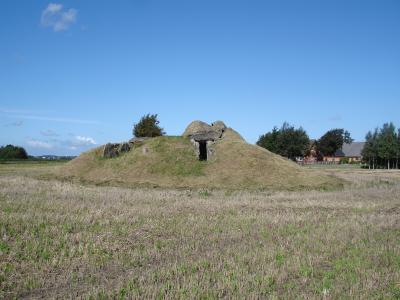
The National Museum of Denmark
Claus Clausen, who graduated as astronomer from the Niels Bohr Institute, has also always been interested in archeology. There are many Stone Age graves in Denmark, where archaeologists estimate that around 40.000 large stone graves were built from around 3500 to 3000 BC.
Only about 500 of the large passage graves, called giant tombs (in Danish Jaettestuer) are preserved today, but one of the great mysteries is their orientation in the landscape
With the help of GPS, a compass and a surveying instrument Claus Clausen measured the orientation of entrance tunnels of approximately 100 passage graves. It turned out that there was a remarkable concentration of certain orientations. Claus Clausen had a theory that it could be a calendar system, but the theory did not hold up.
Astronomer and supervisor of the special project, Per Kjærgaard Rasmussen suggested that he look at the connection between the sun and the moon and especially lunar eclipses, because there were two orientations that occurred frequently and that could suggest something with specific full moons.”
[Full Story]
|